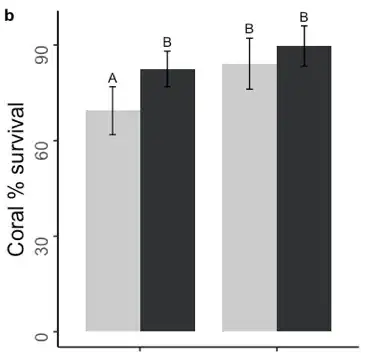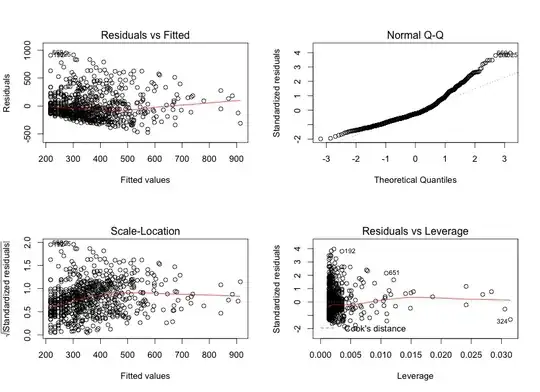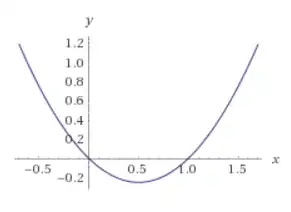I plotted the means and 95% confidence intervals for survival data with the paired bars corresponding to 2 different study sites that each contain two experimental treatments (white = low shelter, black = high shelter). As you can see for the Waikiki site (bars on the left), the 95% CI do not overlap as confirmed by the upper and lower limits that define the error bars in the summary dataframe below.


However, when I run the mixed model for these data, the Site_long x Shelter term is not significant despite the confidence intervals in the figure.
Linear mixed model fit by REML. t-tests use Satterthwaite's method ['lmerModLmerTest']
Formula: Survival_prop ~ Site_long * Shelter + (1 | Season) + (1 | Year)
Data: survival_results_long_2
REML criterion at convergence: 21.7
Scaled residuals:
Min 1Q Median 3Q Max
-3.6051 -0.5895 0.3570 0.6512 1.4160
Random effects:
Groups Name Variance Std.Dev.
Season (Intercept) 0.001181 0.03437
Year (Intercept) 0.002929 0.05412
Residual 0.058588 0.24205
Number of obs: 194, groups: Season, 4; Year, 3
Fixed effects:
Estimate Std. Error df t value Pr(>|t|)
(Intercept) 0.88820 0.04549 3.74510 19.524 6.62e-05 ***
Site_longWaikiki -0.11677 0.03537 186.17978 -3.301 0.00115 **
Shelter.L 0.03558 0.03813 186.39549 0.933 0.35191
Site_longWaikiki:Shelter.L 0.05540 0.04992 185.81545 1.110 0.26852
---
Signif. codes: 0 ‘***’ 0.001 ‘**’ 0.01 ‘*’ 0.05 ‘.’ 0.1 ‘ ’ 1
Correlation of Fixed Effects:
(Intr) St_lnW Shlt.L
Site_lngWkk -0.462
Shelter.L 0.008 -0.010
St_lngW:S.L -0.008 -0.003 -0.764
Is the correct interpretation to say that since the 95% CI bars don't overlap AND the Tukey pairwise multiple comparisons confirm that the means for Waikiki-Low (white bar on left) and Waikiki-High (black bar on left) shelter treatments are significantly different that this interaction is significant despite the model results?
contrast estimate SE df t.ratio p.value
Hanauma Bay Low - Waikiki Low 0.1559 0.0501 186 3.111 0.0115
Hanauma Bay Low - Hanauma Bay High -0.0503 0.0541 187 -0.930 0.7887
Hanauma Bay Low - Waikiki High 0.0273 0.0497 186 0.549 0.9467
Waikiki Low - Hanauma Bay High -0.2063 0.0505 186 -4.083 0.0004
Waikiki Low - Waikiki High -0.1287 0.0456 185 -2.823 0.0269
Hanauma Bay High - Waikiki High 0.0776 0.0501 187 1.550 0.4100
For completeness, I have also provided the model outputs for the simple linear model with and without the interaction term between Site and Shelter:
Simple linear model with interaction term
Call:
lm(formula = Survival_prop ~ Site_long * Shelter, data = survival_results_long_2,
na.action = "na.fail")
Residuals:
Min 1Q Median 3Q Max
-0.8967 -0.1581 0.1033 0.1584 0.3062
Coefficients:
Estimate Std. Error t value Pr(>|t|)
(Intercept) 0.86915 0.02748 31.631 <2e-16 ***
Site_longWaikiki -0.10989 0.03601 -3.052 0.0026 **
Shelter.L 0.03899 0.03886 1.003 0.3169
Site_longWaikiki:Shelter.L 0.05364 0.05092 1.053 0.2935
---
Signif. codes: 0 ‘***’ 0.001 ‘**’ 0.01 ‘*’ 0.05 ‘.’ 0.1 ‘ ’ 1
Residual standard error: 0.2473 on 190 degrees of freedom
Multiple R-squared: 0.08609, Adjusted R-squared: 0.07166
F-statistic: 5.966 on 3 and 190 DF, p-value: 0.0006584
Simple linear model without the interaction term
Call:
lm(formula = Survival_prop ~ Site_long + Shelter, data = survival_results_long_2,
na.action = "na.fail")
Residuals:
Min 1Q Median 3Q Max
-0.91909 -0.14268 0.08091 0.18023 0.28998
Coefficients:
Estimate Std. Error t value Pr(>|t|)
(Intercept) 0.86943 0.02748 31.634 < 2e-16 ***
Site_longWaikiki -0.10974 0.03602 -3.047 0.00264 **
Shelter.L 0.07023 0.02512 2.796 0.00571 **
---
Signif. codes: 0 ‘***’ 0.001 ‘**’ 0.01 ‘*’ 0.05 ‘.’ 0.1 ‘ ’ 1
Residual standard error: 0.2473 on 191 degrees of freedom
Multiple R-squared: 0.08076, Adjusted R-squared: 0.07113
F-statistic: 8.39 on 2 and 191 DF, p-value: 0.0003219
All input is appreciated thank you!

